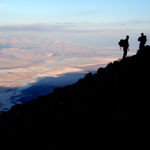
Death Valley National Park – Finding of No Significant Impact Approves Wilderness and Backcountry Stewardship Plan
The National Park Service (NPS) has approved a Wilderness and Backcountry Stewardship Plan for Death Valley National Park, concluding a 4-year public planning process.
The purpose of this plan is to guide the National Park Service in making decisions regarding the future use and protection of Death Valley National Park’s vast wilderness and backcountry lands. This planning process addressed all Congressionally-designated wilderness lands within Death Valley National Park and is the first such plan in the National Park Service to incorporate comprehensive wilderness character analysis. The plan also includes non-wilderness backcountry concerns such as, backcountry road corridors and campsites, backcountry cabins near roads, and non-wilderness backcountry lands. The plan does not address developed or frontcountry areas within the park, nor does it address the Saline Valley Warm Springs area.
After conducting an environmental planning process that included three counties as cooperating agencies, providing four opportunities for public input, and considering more than 400 public comments on the Wilderness and Backcountry Stewardship Plan Environmental Assessment, the NPS has concluded that its selected Alternative D will not result in a significant impact to park resources, the socio-economic environment, public health, or visitor experience.
What in the plan will affect canyoneering?
Permits
Permits will be required for all overnight wilderness and some overnight backcountry use, including overnight use at backcountry cabins, in designated roadside camping corridors, at primitive campgrounds, and in wilderness areas. Permits will not be required for dispersed
roadside camping. Permits will be free for the first three years, and then the Park will evaluate its permit process to determine management effectiveness and whether or not a fee-based system is feasible and appropriate. The permit will not be a reservation for a particular area; use of backcountry and wilderness areas will still be on a first-come, first-served basis. The mandatory permit will include a proposed itinerary disclosure to aid in search and rescue, as well as to inform visitor use statistics. Permit terms and conditions will apply. Permits will be issued through multiple venues, including via the internet. If after three years fees are determined feasible and appropriate for this permit system, fees would also be explored for the Emigrant, Wildrose, Thorndike, and Mahogany Flats developed campgrounds. The exact fee would be determined based on NPS policy and comparability study, which involves further public engagement.
A permit system will be instituted for canyoneering activities in Death Valley National Park. In this pilot permit system, permits will be issued on an annual basis to individual canyoneers, with a mechanism for each individual to report number of trips and trip locations. All permits will include terms and conditions to require clean and safe canyoneering practices, environmental sensitivity, and respect for other park visitors. Depending on patterns of visitor use, visitor safety, and resource conditions, the permit system could be modified to a day-use system for specific canyons or for the entire Park. Permits may be free or for a nominal cost, depending on the requirements for the permit system selected.
Group size limits in Wilderness Areas:
Non-Commercial Day Use Hiking and Photography Groups: Limited to 15 people per group.
Group size limits in Backcountry Areas:
Non-Commercial Day Use Hiking and Photography Groups: Limited to 15 people per group and 4 support vehicles. Vehicle travel restricted to existing backcountry roads only.
Camping
The group size limit for dispersed overnight use in wilderness will be 12 individuals per private party per night. The group size limit for dispersed camping along backcountry roads will be 12 individuals and 4 vehicles per private party per night. A requirement to pack out solid waste and toilet paper using a sanitary system will be implemented during high use seasons as needed along the Cottonwood Canyon and Marble Canyon Loop, including both the roads and hiking route.
Commercial Services and Non-Commercial Activities in Wilderness
The selected action is guided by a determination of the extent commercial services are necessary for realizing the purposes of Death Valley National Park’s wilderness, outlined and documented in Appendix J of the Plan/EA.
• Commercial Day Use Guided Canyoneering Groups: Not allowed in wilderness.
• Commercial Day Use Guided Climbing Groups: Not allowed in wilderness.
Specialized Recreation in Wilderness • Climbing and Canyoneering
Climbing and canyoneering are both legitimate recreational pursuits recognized by the selected action, but there are limitations on where and under what conditions they may be appropriate. Clean climbing techniques involving the use of temporary equipment and anchors that can be placed and removed without altering the environment (e.g. slings, webbing, cams, nuts, chocks, and stoppers) are preferred and should be the norm. No additional climbing hardware such as bolts may be left in a fixed location without review by the park’s Wilderness Committee and approval from the Superintendent; however, if an existing bolt or other existing hardware is unsafe, it may be replaced in kind. The occasional placement of a fixed anchor or webbing for belay, rappel, or protection purposes does not necessarily impair the future enjoyment of the wilderness. However, climbing and canyoneering practices with the least negative impact on wilderness resources and character will be the preferred choice. Intensively bolted routes are not appropriate in wilderness. The physical altering of rock surfaces such as chiseling or the intentional removal of lichens or plants, glue reinforcement of existing holds, and gluing of new holds is prohibited. The use of motorized drills is prohibited within wilderness, and rock climbing is not allowed within 200 yards of an archeological or cultural site. These public use restrictions will be included in the park’s Compendium.
